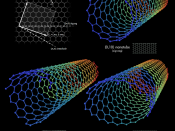Hammitt 6
Jonathan Hammitt
Com 203
L. Behny
09/13/2014
First Draft Carbon Nanotube Processing
Computer technology has made leaps and bounds over the course of the past few decades. Huge super computers that could only do miniscule calculations transformed into small handheld devices, and at the core of all of these systems is the central processing unit. Over the years, the power of the CPU has exponentially increased, increasing the amount of transistors contained within the unit from thousands to hundreds of millions. The new generation of processors has afforded us limitless capability when it comes to computing technology, however, one of the latest problems facing processors today is heat dissipation and cooling. For years, copper heat sinks in combination with fans have been the cooling solution of choice, but it will not be long before processors produce too much heat for even the best cooling technology has to offer.
Thankfully, other technologies have been in development and could possibly provide a solution. This expository will provide a definition for carbon nanotube technology, its potential role in CPU cooling, and finally, the future of computer technology.
In order to understand how carbon nanotubes can solve cooling issues, it is important to understand the basics of the cooling process in personal computers. Heat sinks are giant radiator-like devices that utilize copper in conjunction with a TIM, normally made of silver compound, to transfer heat from the CPU to an array of fins that are finally dissipated by a case fan. The process is called phase change. According to Extremetech, one of the many problems facing new CPUs today is the efficient transmission of heat between CPU and the heat sink that cools them. The problem exists because modern thermal interface compounds, or TIMs, are horrible at conducting heat and processors...


